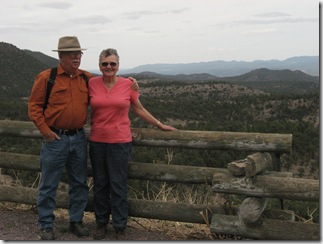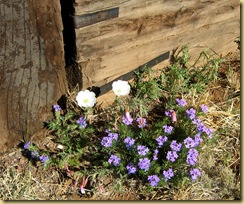Over 450 years ago, Francisco Vazquez de Coronado took 1400 men on a fantastic trip through Arizona, New Mexico, Texas, Oklahoma and Kansas seeking the fabled Seven Golden Cities of Cibola. Although he never found his cities, his exploration established much of Spain’s later claim to the huge Southwest.
Today, the official Coronado Trail Scenic Byway runs from Clifton, AZ to Springerville, AZ.
We asked square dance friends, Ron and Kay Henderson, to accompany us as we drove much of the byway’s length, from Clifton, AZ to Alpine, AZ.
 Ron worked for the Forestry Department for years and is a “walking history tome”. He gave us a running commentary throughout the drive, adding background to the fabulous scenery.
Ron worked for the Forestry Department for years and is a “walking history tome”. He gave us a running commentary throughout the drive, adding background to the fabulous scenery.
The town of Clifton (derived from Cliff Town, appropriately) was founded in the 1870’s The nearby river water was necessary to the copper smelters serving the mines. Although Clifton remains, most of the original Main Street is boarded up.
Next town northward is Morenci, North America’s leading copper producer. The mine, which seems to stretch on for miles, boggles the imagination. In recent years, it has produced more than 1 billion pounds of copper annually.
The trucks working in this mine have tires that are 10 feet in diameter, and the trucks appear too tiny in this photo to discern.
Beyond Morenci, the road ascends in elevation rapidly.There is a 6,000-foot change of elevation, starting from the topography of the Upper Sonoran Desert to near-alpine meadows high in the White Mountains.The road, in less than 100 miles carries you through changes in climate, soil, moisture and elevation the same as you would see on a road trip from Mexico to Canada!
![IMG_2049 [50%] IMG_2049 [50%]](http://lh4.ggpht.com/_IcfOhNeeFYo/Sf-QCbwHM5I/AAAAAAAAF4c/1y8qlglkook/IMG_2049%20%5B50%25%5D_thumb%5B2%5D.jpg?imgmax=800) This is not a road to be traversed swiftly. The Federal Highway Administration considers this drive to be the curviest road in the nation. There are nearly 450 switchbacks, (many marked at 10 mph) along the route. Nearly each curve, though, affords a wonderful view. Here’s a view of the road ahead through the side window.
This is not a road to be traversed swiftly. The Federal Highway Administration considers this drive to be the curviest road in the nation. There are nearly 450 switchbacks, (many marked at 10 mph) along the route. Nearly each curve, though, affords a wonderful view. Here’s a view of the road ahead through the side window.
We stopped to take in the view at Blue Vista overlook, perched on the edge of the Mogollon Rim.
The Rim rises 4,000 feet from the valley below.
![IMG_2123 [50%] IMG_2123 [50%]](http://lh6.ggpht.com/_IcfOhNeeFYo/Sf-QM34_gMI/AAAAAAAAF40/XmHyZ5e48k4/IMG_2123%20%5B50%25%5D_thumb%5B4%5D.jpg?imgmax=800) In the midst of the Ponderosa pines and alligator juniper of the high elevations, we stopped for a picnic lunch.
In the midst of the Ponderosa pines and alligator juniper of the high elevations, we stopped for a picnic lunch.
![IMG_2166 [50%] IMG_2166 [50%]](http://lh6.ggpht.com/_IcfOhNeeFYo/Sf-QP14z4TI/AAAAAAAAF48/UCS7JcA-qIQ/IMG_2166%20%5B50%25%5D_thumb%5B2%5D.jpg?imgmax=800) Shortly thereafter, we were amazed to see snow laying alongside the road and in the shade of the forests. Ron just had to stop and hold the snow. It’s not often anymore that we see snow!
Shortly thereafter, we were amazed to see snow laying alongside the road and in the shade of the forests. Ron just had to stop and hold the snow. It’s not often anymore that we see snow!
![IMG_2239 [50%] IMG_2239 [50%]](http://lh4.ggpht.com/_IcfOhNeeFYo/Sf-QT4eht-I/AAAAAAAAF5E/0duNatcfsgk/IMG_2239%20%5B50%25%5D_thumb%5B3%5D.jpg?imgmax=800) Ron Henderson writes many historical papers about the area, particularly about almost forgotten cemeteries. We stopped at one such cemetery on the way back, almost hidden in the grass.
Ron Henderson writes many historical papers about the area, particularly about almost forgotten cemeteries. We stopped at one such cemetery on the way back, almost hidden in the grass. ![IMG_2234 [50%] IMG_2234 [50%]](http://lh6.ggpht.com/_IcfOhNeeFYo/Sf-QX8mHBiI/AAAAAAAAF5M/G9BYMLInahY/IMG_2234%20%5B50%25%5D_thumb%5B2%5D.jpg?imgmax=800)
We left Silver City at 8 a.m. and arrived back, tired, at 6:30 p.m., but what a drive we had experienced.
![IMG_1900 [50%] IMG_1900 [50%]](http://lh5.ggpht.com/_IcfOhNeeFYo/Sf-PyYrw17I/AAAAAAAAF38/vB1tTypJNzs/IMG_1900%20%5B50%25%5D_thumb%5B6%5D.jpg?imgmax=800)
![IMG_1939 [50%] IMG_1939 [50%]](http://lh6.ggpht.com/_IcfOhNeeFYo/Sf-P48Ynx9I/AAAAAAAAF4E/azUCvBbbL1Y/IMG_1939%20%5B50%25%5D_thumb%5B5%5D.jpg?imgmax=800)
![IMG_1946 [50%] IMG_1946 [50%]](http://lh6.ggpht.com/_IcfOhNeeFYo/Sf-P8lQ0TAI/AAAAAAAAF4M/lEQ9g_mh2q8/IMG_1946%20%5B50%25%5D_thumb%5B4%5D.jpg?imgmax=800)
![IMG_1989b [50%] IMG_1989b [50%]](http://lh5.ggpht.com/_IcfOhNeeFYo/Sf-P_pNXWBI/AAAAAAAAF4U/ooxWR248WEk/IMG_1989b%20%5B50%25%5D_thumb%5B3%5D.jpg?imgmax=800)
![IMG_2097 [50%] IMG_2097 [50%]](http://lh4.ggpht.com/_IcfOhNeeFYo/Sf-QFfqjflI/AAAAAAAAF4k/Se0KQDHQtl4/IMG_2097%20%5B50%25%5D_thumb%5B3%5D.jpg?imgmax=800)
![slideshow [50%] slideshow [50%]](http://lh4.ggpht.com/_IcfOhNeeFYo/Sf-QZIeYzoI/AAAAAAAAF5Q/hQFiFIUTlRo/slideshow%20%5B50%25%5D%5B6%5D.jpg?imgmax=800)
![Capture2 [50%] Capture2 [50%]](http://lh4.ggpht.com/_IcfOhNeeFYo/SftZBkZupCI/AAAAAAAAFtU/1k3KOPY77lQ/Capture2%20%5B50%25%5D_thumb%5B3%5D.jpg?imgmax=800)
![IMG_1540 [50%] IMG_1540 [50%]](http://lh5.ggpht.com/_IcfOhNeeFYo/SftZJeLUXwI/AAAAAAAAFtc/WcatDUdP1Z4/IMG_1540%20%5B50%25%5D_thumb%5B1%5D.jpg?imgmax=800)
![IMG_1651 [50%] IMG_1651 [50%]](http://lh3.ggpht.com/_IcfOhNeeFYo/SftZUHMXwYI/AAAAAAAAFtk/eyy4m6I6KQ8/IMG_1651%20%5B50%25%5D_thumb%5B2%5D.jpg?imgmax=800)
![IMG_1736 [50%] IMG_1736 [50%]](http://lh5.ggpht.com/_IcfOhNeeFYo/SftZbm6DVZI/AAAAAAAAFts/-StVq7nzAuU/IMG_1736%20%5B50%25%5D_thumb%5B1%5D.jpg?imgmax=800)
![IMG_1667 [50%] IMG_1667 [50%]](http://lh5.ggpht.com/_IcfOhNeeFYo/SftZlPrJ3tI/AAAAAAAAFt0/B6ZJXietGSg/IMG_1667%20%5B50%25%5D_thumb%5B1%5D.jpg?imgmax=800)
![IMG_1662b [50%] IMG_1662b [50%]](http://lh5.ggpht.com/_IcfOhNeeFYo/SftZtYfwzYI/AAAAAAAAFt8/WHJlg0zaHAQ/IMG_1662b%20%5B50%25%5D_thumb%5B2%5D.jpg?imgmax=800)
![IMG_1697 [50%] IMG_1697 [50%]](http://lh3.ggpht.com/_IcfOhNeeFYo/SftZ0bA6ryI/AAAAAAAAFuE/ej7zhwp0ITs/IMG_1697%20%5B50%25%5D_thumb%5B2%5D.jpg?imgmax=800)
![IMG_1705 [50%] IMG_1705 [50%]](http://lh5.ggpht.com/_IcfOhNeeFYo/SftaAcWYoJI/AAAAAAAAFuM/3oIMdo8i6Tg/IMG_1705%20%5B50%25%5D_thumb%5B5%5D.jpg?imgmax=800)
![IMG_1716 [50%] IMG_1716 [50%]](http://lh3.ggpht.com/_IcfOhNeeFYo/SftaGxucByI/AAAAAAAAFuU/ldjtumXPmw8/IMG_1716%20%5B50%25%5D_thumb%5B1%5D.jpg?imgmax=800)
![IMG_1714 [50%] IMG_1714 [50%]](http://lh4.ggpht.com/_IcfOhNeeFYo/SftaMc-j6fI/AAAAAAAAFuc/_SZwZAMB6DI/IMG_1714%20%5B50%25%5D_thumb%5B1%5D.jpg?imgmax=800)
![IMG_1712 [50%] IMG_1712 [50%]](http://lh6.ggpht.com/_IcfOhNeeFYo/SftaVkUI5UI/AAAAAAAAFuk/5pDsD_cCj1E/IMG_1712%20%5B50%25%5D_thumb%5B1%5D.jpg?imgmax=800)
![IMG_1747 [50%] IMG_1747 [50%]](http://lh6.ggpht.com/_IcfOhNeeFYo/SftaZb8pGrI/AAAAAAAAFus/7FZ_K1fPEi0/IMG_1747%20%5B50%25%5D_thumb%5B3%5D.jpg?imgmax=800)
![slideshow [50%] slideshow [50%]](http://lh5.ggpht.com/_IcfOhNeeFYo/SftabWXIV-I/AAAAAAAAFuw/-qS1ODNMOqA/slideshow%20%5B50%25%5D%5B5%5D.jpg?imgmax=800)
![IMG_1486 [35%] IMG_1486 [35%]](http://lh6.ggpht.com/_IcfOhNeeFYo/SfsQBB-uFZI/AAAAAAAAFnk/TpFt0r5pa2U/IMG_1486%20%5B35%25%5D_thumb%5B4%5D.jpg?imgmax=800)
![IMG_1490 [35%] IMG_1490 [35%]](http://lh3.ggpht.com/_IcfOhNeeFYo/SfsQFgSpTZI/AAAAAAAAFn0/dSfJUO2BNRA/IMG_1490%20%5B35%25%5D_thumb%5B5%5D.jpg?imgmax=800)
![scan0018 [35%] scan0018 [35%]](http://lh4.ggpht.com/_IcfOhNeeFYo/SfsQKxZVf0I/AAAAAAAAFn8/G9O3tDuGIxs/scan0018%20%5B35%25%5D_thumb%5B2%5D.jpg?imgmax=800)
![Stitched_002b [35%] Stitched_002b [35%]](http://lh6.ggpht.com/_IcfOhNeeFYo/SfsQO9qX09I/AAAAAAAAFoE/u18_qR7L6os/Stitched_002b%20%5B35%25%5D_thumb%5B7%5D.jpg?imgmax=800)
![IMG_1506b [35%] IMG_1506b [35%]](http://lh6.ggpht.com/_IcfOhNeeFYo/SfsQTbEt1CI/AAAAAAAAFoM/w4dC3ZTI6TI/IMG_1506b%20%5B35%25%5D_thumb%5B5%5D.jpg?imgmax=800)
![IMG_1510b [35%] IMG_1510b [35%]](http://lh6.ggpht.com/_IcfOhNeeFYo/SfsQWpFEJgI/AAAAAAAAFoU/B4Ew7JIiUGk/IMG_1510b%20%5B35%25%5D_thumb%5B6%5D.jpg?imgmax=800)
![IMG_1513b [35%] IMG_1513b [35%]](http://lh5.ggpht.com/_IcfOhNeeFYo/SfsQay-uXtI/AAAAAAAAFoc/nN0K48BnNPQ/IMG_1513b%20%5B35%25%5D_thumb%5B6%5D.jpg?imgmax=800)
![IMG_1514b [35%] IMG_1514b [35%]](http://lh5.ggpht.com/_IcfOhNeeFYo/SfsQeyQ-8hI/AAAAAAAAFok/WKNIlytDN9o/IMG_1514b%20%5B35%25%5D_thumb%5B5%5D.jpg?imgmax=800)
![IMG_1764 [25%] IMG_1764 [25%]](http://lh4.ggpht.com/_IcfOhNeeFYo/SfsAgSdrgaI/AAAAAAAAFl0/EOPwHZbmbRs/IMG_1764%20%5B25%25%5D_thumb%5B1%5D.jpg?imgmax=800)
![IMG_1780 [25%] IMG_1780 [25%]](http://lh4.ggpht.com/_IcfOhNeeFYo/SfsAkwE1N0I/AAAAAAAAFmM/iaXWYpFIRvg/IMG_1780%20%5B25%25%5D_thumb%5B1%5D.jpg?imgmax=800)
![IMG_1768 [25%] IMG_1768 [25%]](http://lh4.ggpht.com/_IcfOhNeeFYo/SfsAo2_hwlI/AAAAAAAAFmk/mmAj1Kl0FuU/IMG_1768%20%5B25%25%5D_thumb%5B1%5D.jpg?imgmax=800)

![IMG_2246 [50%] IMG_2246 [50%]](http://lh5.ggpht.com/_IcfOhNeeFYo/SfsAwnsPVNI/AAAAAAAAFkw/8JA-y2UGvV8/IMG_2246%20%5B50%25%5D_thumb%5B3%5D.jpg?imgmax=800)
![IMG_1135 [50%] IMG_1135 [50%]](http://lh5.ggpht.com/_IcfOhNeeFYo/SfZH_a11zhI/AAAAAAAAFiU/3BQNgypeLV4/IMG_1135%20%5B50%25%5D_thumb%5B3%5D.jpg?imgmax=800)
![IMG_1119b.TIF [50%] IMG_1119b.TIF [50%]](http://lh3.ggpht.com/_IcfOhNeeFYo/SfZIM-kFwII/AAAAAAAAFic/oUnKzGlg79k/IMG_1119b.TIF%20%5B50%25%5D_thumb%5B2%5D.jpg?imgmax=800)
![IMG_1145b.TIF [50%] IMG_1145b.TIF [50%]](http://lh4.ggpht.com/_IcfOhNeeFYo/SfZIeJC1O2I/AAAAAAAAFik/DDFi7botL0s/IMG_1145b.TIF%20%5B50%25%5D_thumb%5B1%5D.jpg?imgmax=800)
![IMG_7057 [50%] IMG_7057 [50%]](http://lh6.ggpht.com/_IcfOhNeeFYo/SfZIvq6JYrI/AAAAAAAAFis/lWqit4wKBgg/IMG_7057%20%5B50%25%5D_thumb%5B1%5D.jpg?imgmax=800)
![IMG_1195 [50%] IMG_1195 [50%]](http://lh4.ggpht.com/_IcfOhNeeFYo/SfZJBuUXZVI/AAAAAAAAFi0/r7NjIkFjyKg/IMG_1195%20%5B50%25%5D_thumb%5B3%5D.jpg?imgmax=800)
![IMG_1238 [50%] IMG_1238 [50%]](http://lh4.ggpht.com/_IcfOhNeeFYo/SfZJRSQ8OBI/AAAAAAAAFi8/X9OyC4yFt_Q/IMG_1238%20%5B50%25%5D_thumb%5B2%5D.jpg?imgmax=800)
![IMG_1009 - Copy [50%] IMG_1009 - Copy [50%]](http://lh5.ggpht.com/_IcfOhNeeFYo/SfZJbKkifgI/AAAAAAAAFjA/gQfA-Vcsdhk/IMG_1009%20-%20Copy%20%5B50%25%5D%5B7%5D.jpg?imgmax=800)
![IMG_0766 [35%] IMG_0766 [35%]](http://lh6.ggpht.com/_IcfOhNeeFYo/SfI-pMMT8VI/AAAAAAAAFWo/AN3joFg7Buw/IMG_0766%20%5B35%25%5D_thumb%5B1%5D.jpg?imgmax=800)
![IMG_0771 [50%] IMG_0771 [50%]](http://lh6.ggpht.com/_IcfOhNeeFYo/SfI-qZVyMmI/AAAAAAAAFWw/U3TeFe4Dmg8/IMG_0771%20%5B50%25%5D_thumb%5B1%5D.jpg?imgmax=800)
![IMG_0776 [50%] IMG_0776 [50%]](http://lh3.ggpht.com/_IcfOhNeeFYo/SfI-rc_P2XI/AAAAAAAAFW4/aOoFdRzc6O0/IMG_0776%20%5B50%25%5D_thumb%5B1%5D.jpg?imgmax=800)
![IMG_0780 [50%] IMG_0780 [50%]](http://lh5.ggpht.com/_IcfOhNeeFYo/SfI-smCMBSI/AAAAAAAAFXA/R3DffHByRzA/IMG_0780%20%5B50%25%5D_thumb.jpg?imgmax=800)
![IMG_0779 [50%] IMG_0779 [50%]](http://lh3.ggpht.com/_IcfOhNeeFYo/SfI-ty7ZISI/AAAAAAAAFXI/WvnSVyIgwug/IMG_0779%20%5B50%25%5D_thumb%5B1%5D.jpg?imgmax=800)
![IMG_0902 [50%] IMG_0902 [50%]](http://lh3.ggpht.com/_IcfOhNeeFYo/SfI-vQ_ntnI/AAAAAAAAFXQ/2RwkOw1nZ_0/IMG_0902%20%5B50%25%5D_thumb%5B1%5D.jpg?imgmax=800)
![IMG_0939 [50%] IMG_0939 [50%]](http://lh3.ggpht.com/_IcfOhNeeFYo/SfI-wtiiahI/AAAAAAAAFXY/hLnnURtDomo/IMG_0939%20%5B50%25%5D_thumb%5B2%5D.jpg?imgmax=800)
![Slideshow link [50%] Slideshow link [50%]](http://lh6.ggpht.com/_IcfOhNeeFYo/SfI-xBIzKhI/AAAAAAAAFXc/jkf2iI3O9Sc/Slideshow%20link%20%5B50%25%5D%5B5%5D.jpg?imgmax=800)
